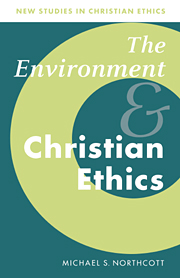Book contents
- Frontmatter
- Contents
- General editor's preface
- Preface
- Acknowledgements
- 1 Frogs, floods and famines
- 2 The origins of the environmental crisis
- 3 The turn to nature
- 4 The flowering of ecotheology
- 5 The order of creation
- 6 Creation, redemption and natural law ethics
- 7 Natural law and ecological society
- Notes
- Index
- New Studies in Christian Ethics
1 - Frogs, floods and famines
Published online by Cambridge University Press: 07 October 2009
- Frontmatter
- Contents
- General editor's preface
- Preface
- Acknowledgements
- 1 Frogs, floods and famines
- 2 The origins of the environmental crisis
- 3 The turn to nature
- 4 The flowering of ecotheology
- 5 The order of creation
- 6 Creation, redemption and natural law ethics
- 7 Natural law and ecological society
- Notes
- Index
- New Studies in Christian Ethics
Summary
In 1991 in the South of England gardeners and naturalists reported a mass death of frogs in garden ponds, small lakes, commons and village greens. Scientists were unable to say what had caused their death on such a large scale, but hundreds of children and parents, many of whom had created a habitat for these creatures to thrive, were disturbed. The suspicions of the scientists, and the people who saw them die, was that pollutants in the environment, in the water and the air, had become too much for these sensitive creatures, which, like all amphibians, absorb substances in the atmosphere and water through their skins as well as their lungs. Perhaps the frogs represented an involuntary early warning. If they cannot survive in our gardens, how long will it be before the earth becomes too toxic for humans as well?
For many people around the world the environmental crisis is already a matter of survival, for themselves and their children: for millions of people in the Sahel region in Africa whose degraded lands will no longer support their livestock and crops; for the residents of Chernobyl in the Ukraine dying of cancer after a nuclear disaster which the industry had always said could never happen, and the sheep farmers in the Lake District who still cannot sell their contaminated sheep in the market eight years after the accident; for the land Dayaks and nomadic Penans of Sarawak in Malaysia whose ancestral home, the million-year-old tropical forest is being systematically and greedily cut down to be burnt as disposable chopsticks or waste construction materials in incinerators in Japan.
- Type
- Chapter
- Information
- The Environment and Christian Ethics , pp. 1 - 39Publisher: Cambridge University PressPrint publication year: 1996



